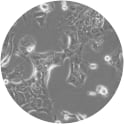BICR 10 Cell Line
Invented by Prof Eric Kenneth Parkinson from Queen Mary University of London
Invented at Cancer Research UK Glasgow: The Beatson Institute
- Datasheet
- References (2)
- Inventor Info
Info
| Catalogue Number | 152841 |
| Host | Human |
| Tissue | Buccal mucosa |
| Disease Keywords | Buccal mucosa squamous carcinoma |
| Model | Tumour line |
| Relevance | Adherent keratinocyte cell line derived from a recurrent squamous cell carcinoma of the buccal mucosa of a Caucasian female. Keratin and involucrin markers present. Known mutations: p53, p16 and p14ARF. Cells are tumourigenic in athymic mice. |
| Research Area | Apoptosis and Programmed Cell Death, Cancer, Drug Discovery & Development, Epigenetics & Nuclear Signalling |
| Growth/Phenotype Keywords | Adherent |
| Recommended Growing Conditions | DMEM + 2mM Glutamine + 10% Foetal Bovine Serum (FBS) + 0.4 micrograms/ml Hydrocortisone. |
| Notes |
STR-PCR Data: Amelogenin: X CSF1PO: 12,14 D13S317: 8,14 D16S539: 9,13 D5S818: 11,13 D7S820: 11,12 THO1: 9.3 TPOX: 8 vWA: 17 |
| Cellosaurus ID | CVCL_2307 |
References: 2 entries
Edington et al. 1995. Mol Carcinog. 13(4):254-65. PMID: 7646764.
Cellular immortality: a late event in the progression of human squamous cell carcinoma of the head and neck associated with p53 alteration and a high frequency of allele loss.
Europe PMC ID: 7646764
Add a reference
References: 2 entries
Edington et al. 1995. Mol Carcinog. 13(4):254-65. PMID: 7646764.
Cellular immortality: a late event in the progression of human squamous cell carcinoma of the head and neck associated with p53 alteration and a high frequency of allele loss.
Add a reference















